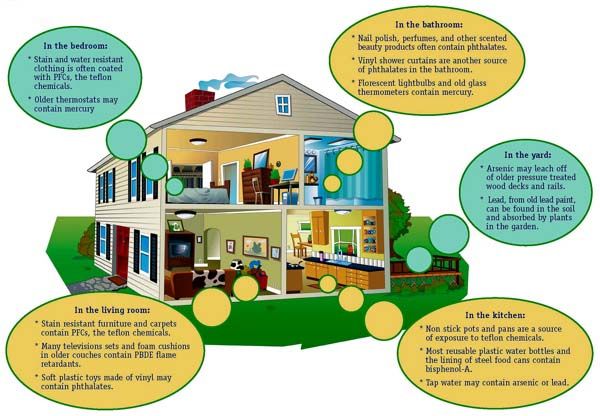Air Purification
The average home is filled with many things which release harmful chemicals into the air. The easiest thing you can do to clear out air pollutants from your home is to turn on the vent/fans and open the doors and windows. Some of the common sources of pollutants are listed below.

Image: courtesy of coalitionforprevention.wordpress.com
- Household cleaners release all kinds of chemicals into the air.
- Pressed-wood cabinets, furniture including beds, and draperies are sources of formaldehyde vapor.
- New vinyl shower curtains and shower liners release large amounts of VOCs, phthalates, and other carcinogens into the air. Fabric shower curtains such as polyester are an excellent alternative.
- Gas stoves release carbon monoxide, nitrogen dioxide, and combustion by-products.
- Biological pollutants are created from mold and mildew that build up in moist areas of bathrooms and kitchens.
- Personal care products (for example, hairsprays) release chemicals into the air.
- Air fresheners smell great, but are carcinogenic.
- Building materials including carpet and paint outgas VOCs (volatile organic compounds).
- Cigarette smoke.
- Animal dander.
- The vapor from moth balls is toxic since it is a pesticide.
- Dry cleaned clothing releases Perchloroethylene (perc).
- Electronics release chemicals in the air, mostly when they’re newer.
- Older homes will contain asbestos in tile, paint, popcorn ceilings, and insulation used for pipe wrap or furnaces.
- Vinyl flooring contains phthalates, which is linked to the development of autism in children.
- Radon is a carcinogenic gas that is released from various sources.
- Adhesives, solvents, paints, cleaning supplies, and finishes release VOCs or other chemicals. They should be used outside whenever possible.
- Chemicals used in steam-cleaning carpet.
- Car exhaust in the garage.
- Pesticides and fertilizers.
For home indoor air pollution, replace traditional cleaners and air fresheners with non-toxic, eco-friendly alternatives. Outgassing of harmful paint chemicals can be virtually eliminated by using Zero VOC paints. Even fumes from stained wooden furniture can be sealed in with products such as AFM Safecoat Hard Seal. It’s recommended that you use HEPA vacuum cleaners and A/C filters.
While ventilating with outside air is best, refrain from doing this during pollen season if you have allergies. Another time to avoid is during periods of heavy traffic if you live close to heavily traveled areas. On that same note, don’t exercise outside or drive with your windows down when there is traffic congestion and pollution is bad.
If you’re looking for even better results and are willing to spend the extra money, you can purchase an air purifier. The cheaper ones produce ozone which is bad for you, so get a high quality air purifier if you plan on getting 1. The best assessment I found of the top air purifiers is available at www.air-purifier-power.com/top-10-air-purifiers.html. IQAir received the highest ratings. They have several models which provide varying levels of filtration - from particle filtration for allergy sufferers to molecular filtration which also filters out chemical pollutants. Be weary of any air purifiers that generate what they call "activated oxygen". These products produce a high level of ozone and will negatively impact your health.
Don't forget that some of the same problems also apply to the air quality in your car. The air fresheners and smell of cleaning products are unhealthy. And the new car smell is really the result of car upholstery outgassing harmful chemicals. I still get carwashes, but now I request them to use their plainest soap and I pass up on the air freshener sprays. Some of you may wonder how bad your house or car would smell without the industrial strength cleaners. As long as you ventilate frequently and keep your home and car relatively clean, there won't be any bad odors.
Source: doi:10.1016/j.neuro.2009.01.011